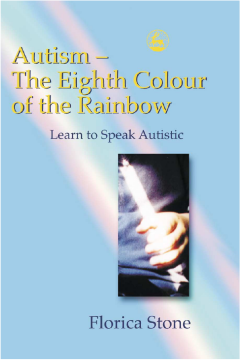
Additional Information
Book Details
Abstract
Through her questioning of traditional approaches regarding autism, and with determination and patience, Florica Stone has been able to develop a satisfying and supportive two-way channel of communication with her once non-verbal and solitary autistic son. In Autism – The Eighth Colour of the Rainbow Florica shows how shared meanings can be learnt and expressed between autistic and non-autistic individuals, though they experience radically different perceptions of reality. Through interacting with and listening to her autistic friends and son, she began to understand the autistic learning style and to decipher the various behavioural needs that arise from their particular sensory processing.
In this inspiring, much-needed guide she presents ways of creating autistic-friendly environments, modifying traditional responses to autistic behaviour and using literal learning, and provides many useful examples and exercises. This book will help parents, teachers and professionals to learn how to interact meaningfully with autistic children, continuously enhance communication and bring about long-lasting changes.
Florica Stone is happily married, enjoys parenting three children, hosts workshops and assists parents in their quest for meaningful 24-hour interaction and communication with their autistic child. Between 1994 and 2000 she was a single parent and devoted her life to understanding autism. Florica transformed her home into an open-house autistic Sanctuary. She sheltered and befriended adults with autism who taught her about different thinking and learning styles, and reached out to non-verbal children, bringing language and fun into their lives.
This is a gripping and clearly authoritative account of how an experienced worker, in partnership with a child's mother, explored and developed a wide range of ways in which to communicate and engage with an autistic child. Stone presents a well-structured programme of inquiry, thought, and everyday practice, primarily within the domestic settings and situations all aimed at helping people to overcome the sense that the language of autism is a foreign one.
Care and Health Magazine
Essentially, it consists of an account of how an experienced worker, in partnership with a mother, explored and developed the best ways of communicating and otherwise engaging with an autistic child. The account also provides health and social care staff and carers with guidance and suggestions through a well-structured programme of inquiry, thought and everyday practice within domestic settings although what is offered is also relevant to those working with children in day care and residential settings. This is a really well-executed piece of work.
Care and Health Magazine
Thank you for giving me hope. I am a single mother of a six-year-old Autistic boy, Griffin. People like yourself are very rare and both myself and Griffin thank you for being there. I no longer feel alone.
Michelle Lore, parent
When Stone was told her son was autistic, her first reaction was to seek a cure, as if he had a disease. He next was to find a loving, gentle program offering long-range success. As soon as she and her son completed a promising program, the positive effects faded. She took matters into her own hands by creating a 'shared sanctuary' for her son and herself, and meeting him in his own world with unconditional love and complete acceptance of his autism. As a result, she and her son developed supportive, two-way communication. Stone describes her experiences for parents and teachers of autistic children, knowing full well that unconditional love and acceptance of all an autistic child's behaviors will take adults to their limits of endurance. She also knows through experience that her methods can bring long-term and positive changes.
Book News
